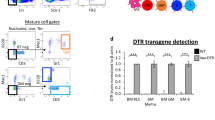Abstract
Two cultured lines of murine embryonal carcinoma, F9 and PCC3, have been grafted to a variety of allogeneic hosts. The host strains have been classified by their resistance or sensitivity to these carcinomas. Resistance seems to be immunological in nature.
Allograft rejection does not correlate withH-2 haplotype, and seems to be controlled by a limited number of recessive factors, presumably histocompatibility genes. We infer that these factors have limited polymorphism in the mouse species. Recombinational analysis of strain A/He has revealed the presence of a recessive factor linked to theH-2 locus. Tumor resistance of strains C57BL/6 and AKR appears to result from the interaction of dominant or semi-dominant factors in theH-2 region with other recessive elements in the genetic background.
Though F1 hybrids between resistant mouse strains and the syngeneic strain 129 are largely tumor-sensitive, a low level of hybrid resistance to F9 has been observed and shown to be eliminated by X-irradiation.
Similar content being viewed by others
References
Artzt, K., Dubois, P., Bennett, D., Condamine, H., Babinet, C., and Jacob, F.: Surface antigens common to mouse cleavage embryos and primitive teratocarcinoma cells in culture.Proc. Natl. Acad. Sci. U.S.A. 70:2988–2992, 1973
Artzt, K. and Jacob, F.: Absence of serologically detectable H-2 on primitive teratocarcinoma cells in culture.Transplantation 17:633–634, 1974
Bailey, D.W.: Recombinant-inbred strains, an aid of finding identity, linkage, and function of histocompatibility and other genes.Transplantation 11:325–327, 1971
Bailey, E.W. and Usama, B.: A rapid method of grafting skin on tails of mice.Transplant. Bull. 7:424–425, 1960
Bernstine, E.G., Hooper, M.L., Grandchamp, S., and Ephrussi, B.: Alkaline phosphatase activity in mouse teratoma.Proc. Natl. Acad. Sci. U.S.A. 70:3899–3903, 1973
Billingham, R.E.: Transplantation immunity and the maternal-fetal relation.N. Engl. J. Med. 270:667–672, 1964
Edidin, M.: Transplantation antigens in the mouse embryo. The fate of early embryo tissues transplanted to adult hosts.J. Embryol. Exp. Morphol. 12:309–316, 1964
Gachelin, G., Kemler, R., Kelly, F., and Jacob, F.: PCC4, a new cell surface antigen common to multi-potential embryonal carcinoma cells, spermatozoa, and mouse early embryos.Dev. Biol. 57:199–209, 1977
Globerson, A. and Feldman, M.: Antigenic specificity of benzo[a]-pyrene-induced sarcomas.J. Natl. Cancer Inst. 32:1229–1243, 1964
Guénet, J.-L., Jakob, H., Nicolas, J.F., and Jacob, F.: Tératocarcinome de la souris: étude cytogénétique de cellules à potentialités multiples.Ann. Microbiol (Paris) 125A:135–151, 1974
Haldane, J.B.S. and Waddington, C.H.: Inbreeding and linkage.Genetics 16:357–374, 1931
Hellström, K.E. and Hellström, I.: Allogeneic inhibition of transplanted tumor cells.Prog. Exp. Tumor Res. 9:40–16, 1967
Hilgert, I. and Snell, G.D.: Resistance to skin grafts induced by cell extracts in congenic strains of mice differing from the donor at various non-H-2 loci.Transplantation 7:401–419, 1969
Jacob, F.: Mouse teratocarcinoma and embryonic antigens.Immunol. Rev. 33:3–32, 1977
Jakob, J., Boon, T., Gaillard, J., Nicolas, J.F., and Jacob, F.: Tératocarcinome de la souris: isolement, culture et propriétés de cellules à potentialités multiples.Ann. Microbiol. (Paris) 124B:269–282, 1974
Klein, J.:Biology of the Mouse Histocompatibility-2Complex. Springer-Verlag, New York, 1975
Martin, G.R.: Teratocarcinomas as a model system for the study of embryogenesis and neoplasia.Cell 5:229–243, 1975.
Nicolas, J.F., Dubois, P., Jakob, H., Gaillard, J., and Jacob, F.: Tératocarcinome de la souris: différenciation en culture d'une lignée de cellules primitives a potentialités multiples.Ann. Microbiol. (Paris) 126A:3–22, 1975
Sanford, B.H. and Soo, S.F.: Resistance to transplants of recent spontaneous parental line tumors by F1 hybrid hosts.J. Natl. Cancer Inst. 46:95–101, 1971
Snell, G.D.: The genetics of transplantation.J. Natl. Cancer Inst. 14:691–700, 1953
Snell, G.D. and Stevens, L.C.: Histocompatibility genes of the mouse. III. H-1 and H-4, two histocompatibility loci in the first linkage group.Immunology 4:366–379, 1961
Snell, G.D., Dausset, J., and Nathenson, S.:Histocompatibility. Academic Press, New York, 1976
Snell, G.D., Graff, R.J. and Cherry, M.: Histocompatibility genes of mice. XI. Evidence establishing a new histocompatibility locus, H-12, and new H-2 allele, H-2bc.Transplantation 11:525–530, 1971
Staats, J.: Standardized nomenclature for inbred strains of mice: sixth listing.Cancer Res. 36:4333–4377, 1976
Stevens, L.C.: Experimental production of testicular teratomas in mice of strains 129, A/He, and their F1 hybrids.J. Natl. Cancer Inst. 44:923–929, 1970a
Stevens, L.C.: The development of transplantable teratocarcinomas from intratesticular grafts of pre- and postimplantation mouse embryos.Develop. Biol. 21:364–382, 1970b
Author information
Authors and Affiliations
Rights and permissions
About this article
Cite this article
Avner, P.R., Dove, W.F., Dubois, P. et al. The genetics of teratocarcinoma transplantation: tumor formation in allogeneic hosts by the embryonal carcinoma cell lines F9 and PCC3. Immunogenetics 7, 103–115 (1978). https://doi.org/10.1007/BF01843995
Received:
Revised:
Issue Date:
DOI: https://doi.org/10.1007/BF01843995




